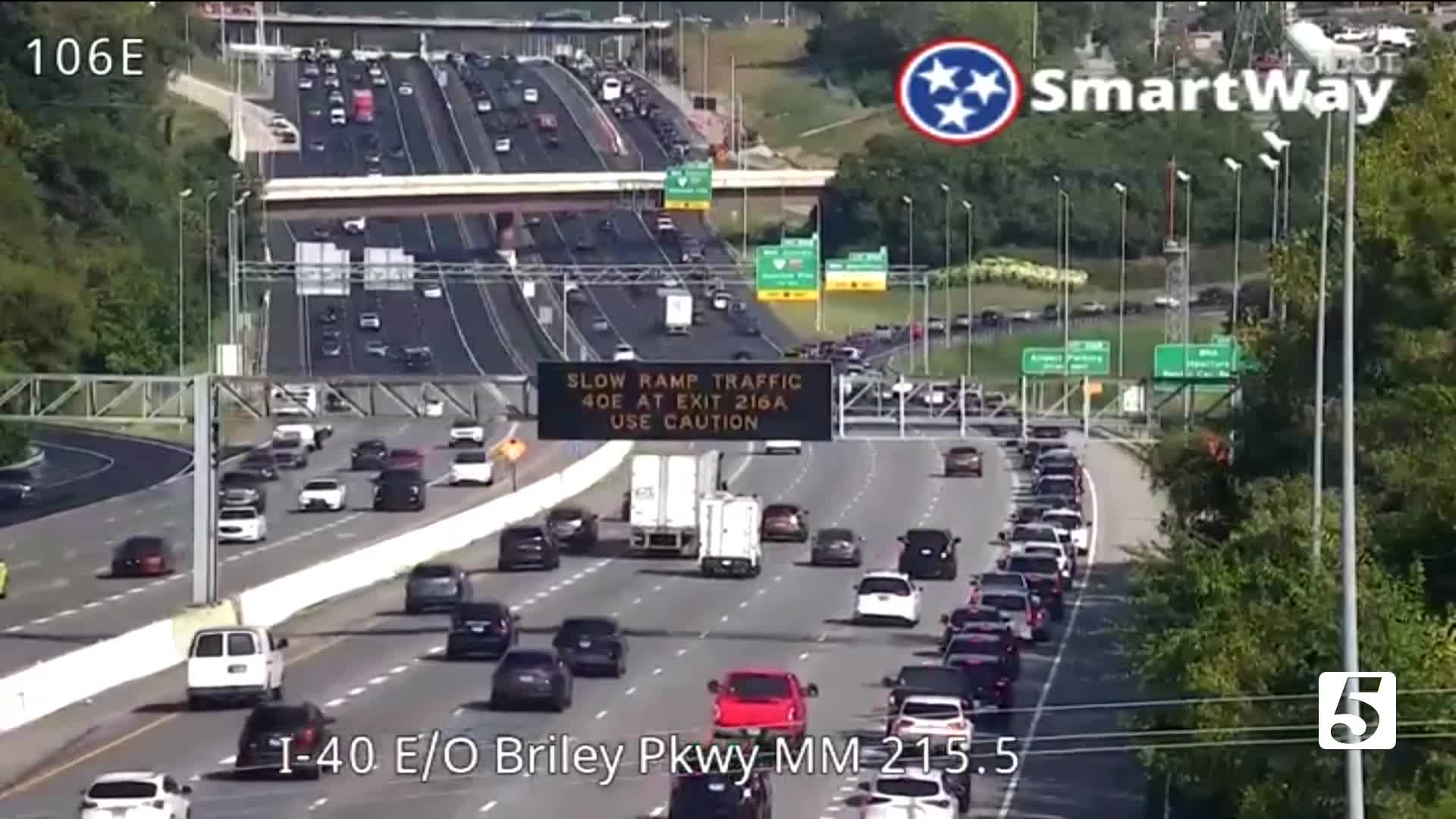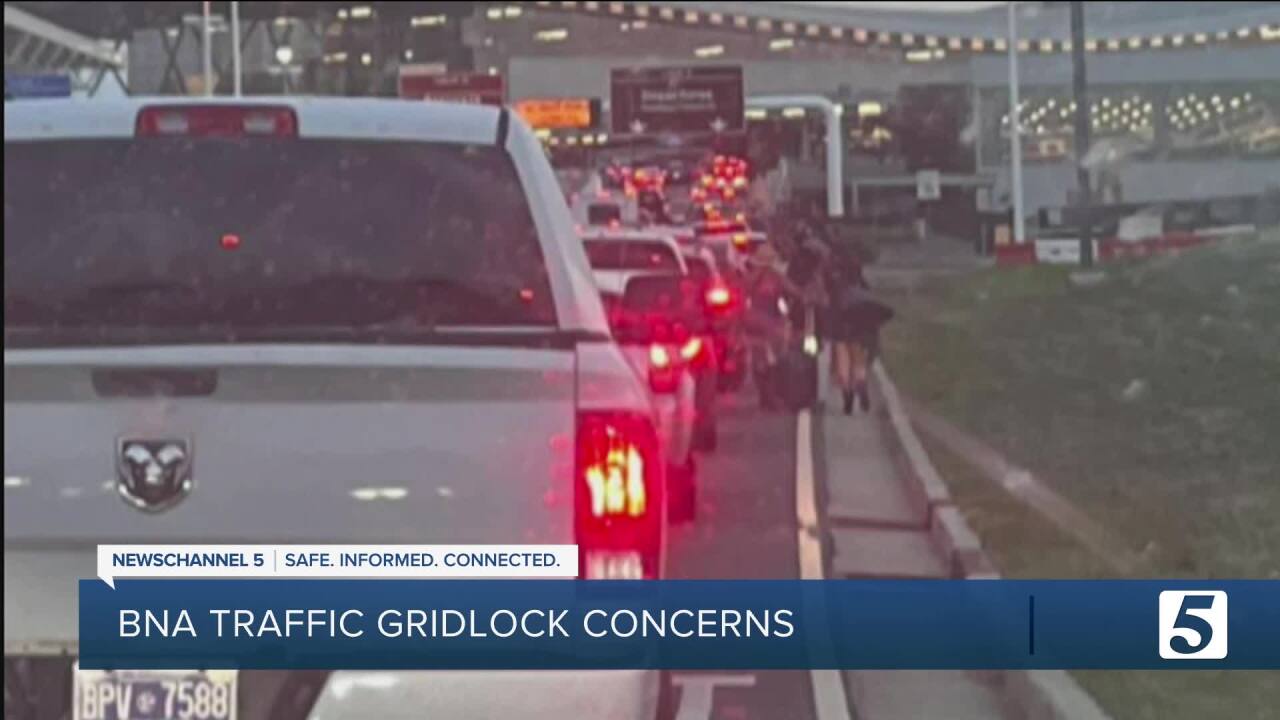NASHVILLE, Tenn. (WTVF) — Hundreds of travelers were stuck in hours-long traffic gridlock at Nashville's airport earlier this month, creating a travel nightmare that lasted more than five hours.
The Tennessee Department of Transportation said in a statement that there was construction on Donelson Pike, but it was not happening when the gridlock became severe. TDOT said they contacted Nashville International Airport to see if traffic management could help with the congestion.
On September 30, BNA released a statement stating they are "committed to addressing the matter directly and transparently"
"Our goal is to prevent an event of this magnitude from occurring again," they said in a statement. "Through this experience, the Metropolitan Nashville Airport Authority has identified five areas that we can improve to strengthen our operations, enhance our communications and improve the overall travel experience at BNA"
"There were literally hundreds of people just standing there," said one traveler who witnessed the chaos.
Brenda Melendez arrived during the earlier part of the afternoon when gridlock was just beginning.
"Nobody's telling us anything. Nobody knows anything. The man in front of me said he had waited an hour and five minutes for his Uber, and then they canceled his ride," Melendez said.
"People were trying to be really nice. Everybody was talking to each other, like, 'Does anybody know what's going on?' Can't figure it out," she said.
TDOT said there was milling and paving at the airport, but they picked up that construction by 1:30 p.m. Phone calls about traffic began about an hour after that.
"It was just a cluster," said one frustrated traveler.
At 3:36 p.m., BNA issued an alert about heavy traffic.
Around 4 p.m., TDOT reported a crash on Terminal Drive.
At 5:44 p.m., BNA said multiple agencies were helping to direct traffic.
But it wasn't until more than five hours later at 11:16 p.m. that BNA announced traffic was back to normal.
Babies were stuck for hours in cars, travelers abandoned their vehicles, and questions and frustrations kept mounting.
"As much as I could see Donelson Pike, there's just brake lights," said Aaron Wilder.
Aaron Wilder landed around 8 p.m. to get home, but traffic hadn't improved, and neither had communication.
"They were just like, yeah, traffic's really bad. It's going to be a long wait. And I was like, cool, that's no help," Wilder said.
After exploring all options, he walked outside the airport, following Donelson Pike while carrying baggage for more than two miles to meet his wife for pickup on an airport service road. He wasn't the only one.
The following five corrective measures will be taken to prevent future occurrences.
1. MNAA Traffic Management: Further strengthening internal staffing procedures for traffic response and mitigation for both planned and unplanned high-volume surges.
2. TNC Collaboration and Coordination: Exploring additional opportunities for further coordination in partnership with Transportation Network Companies (TNC) (rideshare partners) to improve efficiencies on a day-to-day basis such as through improved signage and sharing of real-time data during surges. See attached statements from Uber and Lyft (Page 6).
3. Traffic Modeling and Data Assumptions Reassessment: Reevaluating capacity of the GTC with supporting data from a third-party engineering firm to inform potential maximum pick-up and drop-off requests in coordination with TNC partners. Validating geofencing capabilities and maximum dwell times for rideshare pickups. See attached letter from AtkinsRéalis (Page 7).
4. Maximizing Technological Resources: Implementing technological advancements such as Light Detection and Ranging (LiDAR) to enable real-time traffic monitoring and predictive analytics in the GTC.
5. Traffic Management with Mutual Aid: Strengthening traffic management and enforcement capabilities in partnership with state and local agencies through improved communication and coordination.
"It felt...almost like post-apocalyptic," Wilder said.
"It was necessary to, like, get home. I really wish it didn't have to be that way, but I just feel bad for all the people who are visiting Nashville who have to rely on Uber or Lyft," he said.
"I know the majority of people traveling through BNA probably aren't people who are residents of Tennessee or Nashville, so I just hope that they made it to wherever they were staying safely," Wilder said.
Travelers identified several contributing factors: lack of traffic control officers, airport traffic layout with single lanes, and poor communication. Despite enormous frustration, patience and southern hospitality helped people get through the ordeal, with travelers sharing ride options and helping each other.
BNA has promised an update on the situation.
Did you experience the gridlock traffic at BNA and have thoughts on what went wrong and what questions need answers? Email me at Amanda.Roberts@NewsChannel5.com.
This story was reported on-air by Amanda Roberts and has been converted to this platform with the assistance of AI. Our editorial team verifies all reporting on all platforms for fairness and accuracy.






